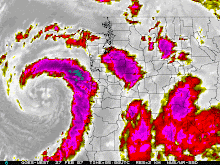Just came across this info from NOAA. The July Temp Breakdown is as follows:
August 15, 2008
The combined average global land and ocean surface temperature for July 2008 tied with 2001 and 2003 as the fifth warmest July since worldwide records began in 1880, according to an analysis by NOAA’s National Climatic Data Center in Asheville, N.C.
Also, the seven months from January to July 2008 ranked as the ninth warmest seven-month period for combined average global land and ocean surface temperature.
Global Temperatures
* The July 2008 combined global land and ocean surface temperature was 0.88 degree F (0.49 degree C) above the 20th century mean of 60.4 degrees F (15.8 degrees C). For the January – July period, the combined global land and ocean surface temperature was 0.81 degree F (0.45 degree C) above the 20th century mean of 56.9 degrees F (13.8 degrees C).
* Separately, the global land surface temperature for July was 1.22 degrees F (0.68 degree C) above the 20th century mean of 57.8 degrees F (14.3 degrees C). For January – July, the global land surface temperature was 1.35 degrees F (0.75 degree C) above the 20th century mean of 46.8 degrees F (8.3 degrees C).
* The July global ocean surface temperature was 0.76 degree F (0.42 degree C) above the 20th century mean of 61.5 degrees F (16.4 degrees C). The January – July global ocean surface temperature was 0.61 degrees F (0.34 degrees C) above the 20th century mean of 61.0 degrees F (16.1 degrees C).
Global Highlights
* El Niño-Southern Oscillation conditions continued neutral through July in the tropical Pacific Ocean, ending the La Niña event that began in mid-2007.
* Northern Hemisphere sea ice extent ranked fourth lowest on record for July. Since 1979, Northern Hemisphere sea ice extent in July has decreased by 6.1 percent per decade. In contrast, the Southern Hemisphere sea ice extent was slightly above the 1979-2000 average and ranked tenth largest for July out of the last 30 years.
* Rains from Hurricane Dolly caused landslides in Guatemala that killed 21 people. The storm, after making landfall at South Padre Island, Texas, on July 23 brought torrential rain and flooding to both the Mexican and U.S. sides of the Rio Grande Valley. Nearly 250,000 people in Mexico were left without safe drinking water.
* Typhoon Kalmaegi/Helen (July 13-20) passed over the Philippines, Taiwan, and eastern China, killing at least 18 and causing about $10 million (U.S.) in damage. Some mountainous locations in Taiwan reported more than 1100 mm (43 inches) of rain during the storm. A few days later (July 23-30), Typhoon Fung-wong passed over many of the same areas, dumping 838 mm (32.9 inches) of rain on Hualien on Taiwan’s east coast. Extensive damage exceeding $6 million (U.S.) and six fatalities were reported.
* Heavy monsoon rains pelted northern India and Bangladesh between July 5-14, resulting in floods and landslides that claimed 20 lives. Eleven people died in monsoon flooding and landslides in Nepal in early July.
* By the end of July, drought conditions improved slightly across China’s northern Xinjiang and Gansu provinces, and in parts of Ningxia and Inner Mongolia provinces, where conditions improved from severe to moderate drought.
Other Key Events
* Two powerful storms struck New Zealand between July 26 – 30, triggering flash flooding and widespread damage caused by winds equivalent to a Category 3 hurricane. On July 5, the Norwegian capital of Oslo was hammered with heavy rain and flash flooding and 97 km/h (60 mph) wind gusts.
* Torrential downpours July 23-26 in South Korea inundated more than 3,000 acres of farmland, damaged more than 600 homes and killed seven. In western Japan, more than 100 mm (four inches) of rain fell in less than two hours, killing four and flooding hundreds of homes. Severe storms over Ukraine and Romania July 25-29 caused the Dniester and Prut rivers to top their banks, flooding nearly 50,000 homes and killing 34 people.
NOAA understands and predicts changes in the Earth's environment, from the depths of the ocean to the surface of the sun, and conserves and manages our coastal and marine resources.
Monday, September 1, 2008
Subscribe to:
Post Comments (Atom)

No comments:
Post a Comment